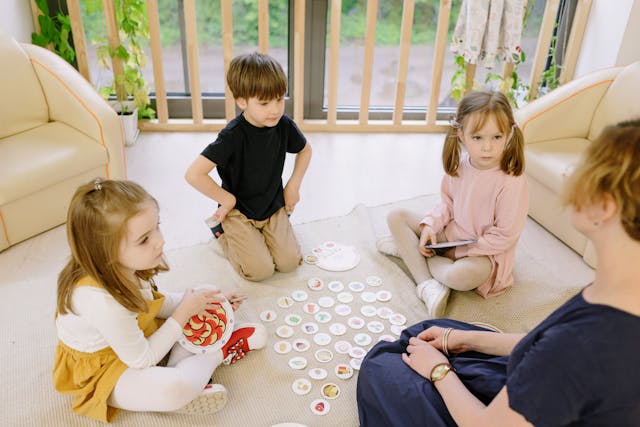|
Download ESL Books + Free PDFs
Save 25% on ESL Books for Teachers & Students Visit the ESL Expat Store and enter "SAVE25" at checkout! |
Using flashcards in the ESL classroom is a tried-and-true method for reinforcing vocabulary, grammar, and sentence structure. But simply showing a card and asking students to repeat the word only goes so far. To really engage students and help them retain new language, you need to turn those cards into interactive, memorable learning tools.
In this article, we’ll share 10 flashcard games every ESL teacher should know, especially those teaching beginners or young learners. These games work in a variety of settings—online, in-person, large groups, or one-on-one—and can be adapted to suit different ages and skill levels.

1. Slap the Card
How to Play:
Place flashcards on the board or table. Call out a word or show a flashcard to the class. Students race to slap the correct card with their hand or a soft object like a flyswatter.
Why It Works:
This game builds quick word recognition and is a hit with energetic students.
Best for: Vocabulary sets like animals, classroom objects, body parts.
2. Memory Match
How to Play:
Prepare two sets of flashcards—either image-to-image or image-to-word. Place them face down and let students take turns flipping two cards to find a match.
Why It Works:
Memory games help reinforce spelling, reading, and visual recognition.
Best for: Colors, food, numbers, verbs.
3. What’s Missing?
How to Play:
Place 4–6 flashcards in front of the class. Have students close their eyes. Remove one card. When they open their eyes, ask, “What’s missing?”
Why It Works:
This simple game develops observation and recall skills, ideal for review.
Best for: Days of the week, weather, school supplies.
4. Flashcard Basketball
How to Play:
Show a flashcard. If the student says the word correctly (or uses it in a sentence), they get to throw a ball into a basket or box for points.
Why It Works:
Combines language learning with physical movement, boosting motivation and engagement.
Best for: Any vocabulary—ideal as a review game at the end of class.
5. Flashcard Race
How to Play:
Split students into two teams. Place flashcards at the far end of the room. Call out a word. One student from each team races to grab the correct card and bring it back.
Why It Works:
Encourages listening comprehension and team collaboration.
Best for: Adjectives, verbs, or any topic with clear visuals.
6. Flashcard Charades
How to Play:
One student picks a flashcard and acts out the word without speaking. The rest of the class guesses what it is.
Why It Works:
Promotes active learning and supports kinesthetic learners.
Best for: Action verbs, emotions, animals.
7. Find the Flashcard
How to Play:
Hide flashcards around the classroom. Give students clues or descriptions to help them find the right card.
Example: “Find something that is red and sweet” (for a flashcard showing an apple).
Why It Works:
This scavenger hunt-style game is great for developing listening and deduction skills.
Best for: Colors, food, and descriptive adjectives.
8. Flashcard Story Builder
How to Play:
Lay out 5–6 flashcards. Students take turns creating a sentence using one card each until they build a silly or creative story.
Why It Works:
Encourages students to think in complete sentences and practice grammar.
Best for: Mixed vocabulary sets or themes like transportation, people, places.
9. Flashcard Hot Potato
How to Play:
Play music while students pass around a flashcard. When the music stops, the student holding the card must say the word, spell it, or use it in a sentence.
Why It Works:
Combines speaking and time pressure, which helps reinforce fluency.
Best for: Vocabulary practice and speaking warm-ups.
10. True or False Flashcard Challenge
How to Play:
Show a flashcard and say a sentence about it (e.g., “This is a dog” while showing a cat). Students respond with “true” or “false.”
Why It Works:
This game boosts listening and critical thinking skills, especially in beginner and low-intermediate classes.
Best for: Animals, occupations, or anything with visual cues.
Final Tips for Using Flashcard Games
To get the most out of these flashcard activities:
-
Use large, colorful flashcards for better visibility.
-
Mix in TPR (Total Physical Response) to keep students moving and engaged.
-
Rotate games regularly to keep lessons fresh and avoid repetition.
-
Pair flashcard activities with pronunciation practice for a more well-rounded lesson.
Final Thoughts
Flashcards are more than just a teaching aid—they’re a gateway to fun, interactive, and effective English learning. The 10 games listed here help turn passive vocabulary review into active learning experiences that your students will love and remember.
Whether you’re teaching kids, teens, or adult beginners, these flashcard games offer a wide range of benefits: improved retention, increased participation, and a livelier classroom environment. Try a new one each week to keep your lessons exciting and impactful.
Download Free Flashcards and Templates
Want new flashcards for your ESL classes?
Click here to download PDF samples and get premium flashcard sets.
